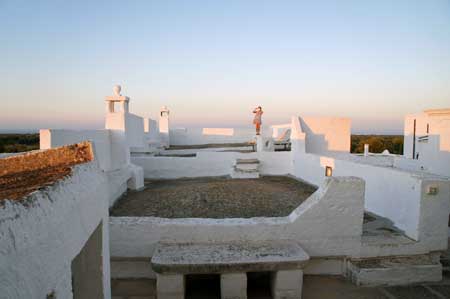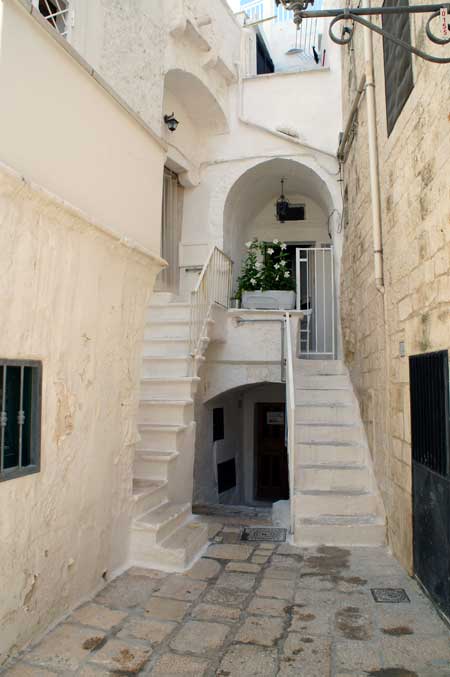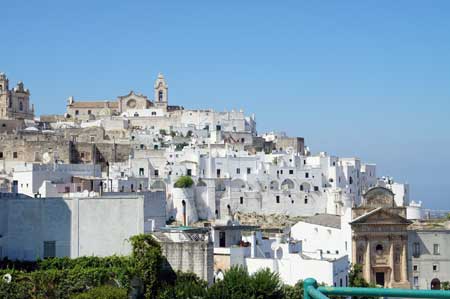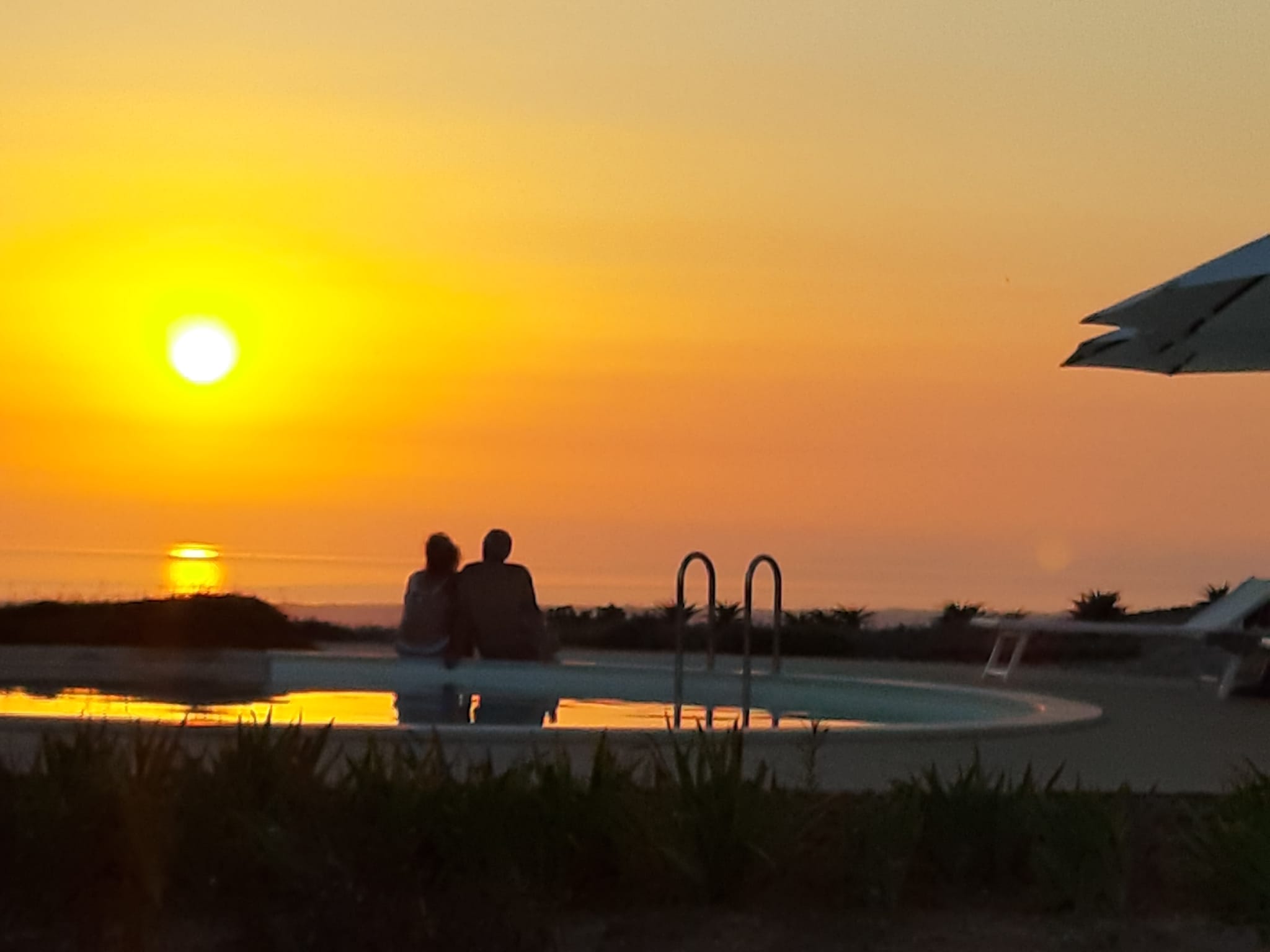One week in Puglia is not enough
Posted on
Anne-Marie Shepherd from Worthing writes: Before we had even reached our holiday accommodation, we were lured by the sight of one of Puglia’s famous ‘white towns’ perched on the hill in the distance. We steered off the motorway, and headed for Ostuni, an ancient looking town, a mess of white washed houses with its cathedral dominating the town’s skyline. Walking the beautiful narrow, stone, higgledy piggledy streets in the heat of the day was almost surreal. There was hardly anyone about, and it would have seemed almost eerie, was it not for the bustle of everyday life coming from the open windows and doors of the homes. Walking aimlessly was a delight; each street more enchanting than the next, with coloured shutters, nooks and crannies, potted cacti, amazing arched window terraces and steep steps leading to brightly coloured doorways and upwards to the roof terraces. We knew we’d be back another time to explore again.
Our accommodation, Borgo San Marco, a wonderful old fort, turned farm, turned hotel was easy to find just off the main Brindisi to Bari road, but amazingly not within earshot of the traffic. It is hard to capture the beauty of Borgo san Marco in pictures. Set in the heart of the Pugliese countryside, surrounded by olive and lemon trees with the odd vine thrown in, it really is a haven of tranquillity. The building is beautiful, with a Moroccan feel to it. Rustic, yet in no way shabby. Simple, yet luxurious and comfortable. The chapel in the walled courtyard adds to the beauty and charm, and we immediately envisaged just how perfect a wedding here would be. With large roof terraces, and beautiful gardens, theres lots of space to relax, take in the views and enjoy the local wines.
Out first dinner at Borgo san Marco blew us away. We asked what was on the menu, the friendly receptionist answered ‘fish’. She was right. There was no menu; we were just brought a whole host of different, delicious fish dishes. Giant prawns, clams in a rich tomato pasta dish, mussels, calamari squid, it was endless and we were delighted. We were giggling at the enormity of the meal and just how tasty it all was.
The next day that we were spoilt for choice as to what to see and do in Puglia. We knew we wanted to see more of the white towns and I was developing an obsession with the trulli – the magical dome shaped huts which dominate this area of Puglia, built centuries ago to house peasant farmers – and which up to now were evading me. So we started by visiting to Martina Franca and Locorotondo, two lovely white towns where we happily meandered and admired the beautiful white streets. And from the heights of Locorotondo, my quest for trulli was achieved. The trulli are truly magical. Rounded shapes with conical stone roofs, littering the landscape, they look like the kinds of houses you’d imagine mythical animals or little beings living in.
My appetite was fully satisfied when we reached Alberobello, the home of over 1000 trulli. Alberobello is like the quaintest of model villages, only you can walk the streets and enter the trulli, shopping, looking at galleries and viewing the town from the terraces and gardens. It’s totally enchanting.
The Baroque city of Lecce is next on our list. Right down in the centre of the heel of Italy, Lecce is known as the Florence of the South, due to its incredible architecture. At every corner of the Old Town, is another example of buildings adorned with incredibly flamboyant stonework of such beauty. We walked and walked the streets, impressed with the magnitude, intricate detail and humour of the work. The stonework and decoration in the Cathedral was simply stunning. In fact even just the ceilings in almost every church we went in were breathtaking. Lecce is an absolute gem and not to be missed.
We headed to Otranto, a seaside town even further south to hit the beach and catch some rays, but also to visit another cathedral steeped in history. In 1480 the town was invaded by the Turks who massacred both the Bishop and the majority of the townspeople, 800 of whom became martyrs because they refused to give up their Christian faith. Their skulls and bones are held behind glass panels in a chapel in the cathedral as a reminder of their faith.
Otranto, like we soon came to realise most of the Pugliese towns, came to life from around 8pm, when the streets are filled to the brim with Italians of all generations out to eat, drink and socialise. After a day on the beach, Italians party in the evenings and it was a joy to see babies, children, teens, parents and grandparents out having fun.
The caves of Castellana were also on our to-do list. Discovered in 1938, these caves are a mile long and breathtaking. Guided tours in English (or German and Italian) take you through the passage ways and chambers full of stalactite, stalagmites and shimmering crystallite. We also discovered the nearby village of Putignano, perfect for a bite of lunch and our daily gelato.
A day by the sea was needed, so we drove along the coast road and stopped just outside Savelleti (a small fishing town with a superb fish restaurant called Maddalena) and joined the Italian families, relaxing in the sandy coves, sunbathing on the rocks and enjoying the incredible warmth of the Adriatic Sea. Heading back to Borgo san Marco in the darkness, a few families and friends were having their dinner out on the rocks overlooking the sea; tables set up beautifully, lit by a portable standing lamp, it looked too idyllic.
Shopping trips to Fasano (Benetton must have seen a surge in profits) and the lovely town of Polignano a Mare with its caves in the cliffs housing bars and restaurants, and an evening trip to Ostuni to join in the evening vibe, saw the end of our week. We decided we had to have one last dinner at Borgo San Marco. This one just excelled. Nine courses were served. Breads, tempura vegetables, tiny quiches, fritters, a pasta dish, a selection meats, vegetables, fruit and to cap it all the king of all chocolate mousses! Just amazing.
I had read in the guidebooks that Puglia still wasn’t used to tourists and that the locals could often be off hand. We found the opposite. Everyone we came across was helpful, smiley, eager to please and eager to chat. Even the old guys running their small town bars welcomed us with their lovely attempts at English grinning all the while.
Puglia is beautiful, unspoilt and enchanting, and we didn’t get to see half of it. Taranto, the villages at the very bottom of the heel, the beach, Baia dei Turchi, which the locals say is the most beautiful beach in Puglia, and the National Park to the north of Bari, all eluded us this time. One week in Puglia is not enough, book two.





